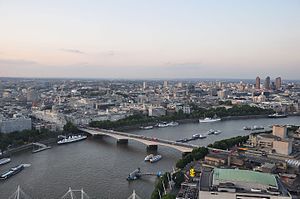Waterloo Bridge
Waterloo Bridge is a road and foot traffic bridge crossing the River Thames in London, England between Blackfriars Bridge and Hungerford Bridge.
Waterloo Bridge | |
|---|---|
 | |
| Coordinates | 51°30′31″N 0°07′01″W / 51.5086°N 0.1169°W |
| Carries | 4 lanes of Motor vehicles and Pedestrians |
| Crosses | River Thames |
| Locale | London, England |
| Heritage status | Grade II* listed structure |
| Characteristics | |
| Design | Arch Bridge |
| Longest span | 71 m |
| History | |
| Opened | 1945 |
| Location | |
 | |
History
changeThe first bridge on the site was designed in 1809-10 by John Rennie for the Strand Bridge Company and opened in 1817 as a toll bridge. The granite bridge had nine arches, each of 120 feet (36.6 m) span, separated by double Grecian-Doric stone columns and was 2,456 feet (748.6 m) long, including approaches. Before its opening it was known as 'Strand Bridge'. During the 1840s the bridge gained a reputation as a popular place for suicide attempts. In 1844 Thomas Hood wrote the poem The Bridge of Sighs about the suicide of a prostitute there.[1] Paintings of the bridge were created by the French Impressionist Claude Monet and English Impressionist, John Constable. The bridge was nationalised in 1878 and given to the Metropolitan Board of Works, who removed the toll from it.
In June 2012, the bridge was highlighted on the route of Queen Elizabeth II's Diamond Jubilee Pageant on the Thames.[2]
Gallery
change-
Crowds attend the opening of Waterloo Bridge on 18 June 1817
-
View of the old Waterloo Bridge from Whitehall stairs, John Constable
-
The design called for supporting beams only at the outside edges, to bring "light and sweetness" to the underside[3]
-
The centre span of the bridge, showing how it is carried on the cantilevered ends of the main beams
-
The completed bridge with the City of London behind
Related pages
changeReferences
change- ↑ Ebeneezer Brewer (1970), Brewers Dictionary of Phrase and Fable Cassell. p.152.
- ↑ Thames Diamond Jubilee Pageant, Key facts Archived 2012-06-05 at the Wayback Machine; Londontown.com, "Thames Jubilee Pageant,"; retrieved 2012-6-4.
- ↑ Giles Gilbert Scott, quoted in Hopkins (1970)
Other websites
changeMedia related to Waterloo Bridge at Wikimedia Commons
- Survey of London entry Archived 2007-09-27 at the Wayback Machine
- Peter Lind & Company Archived 2008-11-21 at the Wayback Machine
- Waterloo Bridge (1917) at Structurae
- Waterloo Bridge (1945) at Structurae